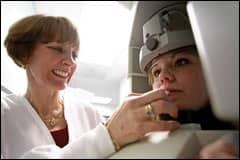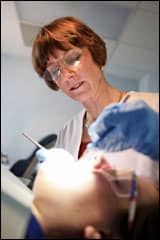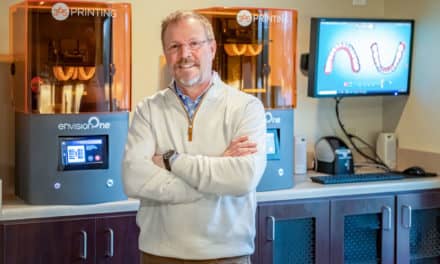by Rich Smith
Driven by a passion for her field, Elizabeth B. Spannhake, DDS, balances clinical, academic, and volunteer work
 |
Among other things, Elizabeth B. Spannhake, DDS, is known for having a meticulously efficient and organized orthodontic practice, one in which patients, procedures, and staff always run on time. As a result, patients seldom wait but a few minutes after arriving before being ushered to the treatment area.
“It comes down to good scheduling—scheduling an appropriate amount of time for each procedure and making sure to group together and dovetail a number of similar procedures during a particular block of time,” says Spannhake, whose 23-year-old Maryland practice mantra and goal is “Simply Outstanding Orthodontics.” “We also conduct initial consults on specific days and during designated times,” she adds. “All of this contributes to our efficiency.”
No surprise, then, to learn that her offices in Mount Airy and Westminster, Md, are hugely popular. What is surprising is that this popularity extends not just to the parents of patients but to the parents who are patients.
“In my practice, adults make up approximately 35% of the patient base,” she says. “Their numbers keep growing every year.”
PRACTICE PROFILE |
|
| Name: | Elizabeth B. Spannhake, DDS, PA Simply Outstanding Orthodontics |
| Location: | Mount Airy, Md; Westminster, Md |
| Owner: | Elizabeth B. Spannhake, DDS, PA |
| Specialty: | Orthodontics |
| Years in practice: | 23 |
| Patients per day: | 60-70 |
| Starts per year: | 300 |
| Days worked per week: | 4 |
| Office square footage: | Westminster 3,000 Mount Airy 2,500 |
Up until about 15 years ago, most of those adult patients were women. Since then, men have accounted for roughly half. “It’s reached the point where it probably would be a good idea to take out subscriptions to Sports Illustrated and Men’s Health for the waiting rooms,” Spannhake jests.
Spannhake believes her practice attracts so many adults because of its prominence in the community and reputation for good orthodontic care. The men who come in (most are 40 and older) are trying to get a leg up on the competition they face in the workplace. “They understand that their ability to climb the corporate ladder depends at least in part on how they look,” she says. “That’s why so many men these days are having plastic surgery or receiving skin-rejuvenation treatments. Having a terrific smile fits right into that.”
One of Spannhake’s practice services popular with both men and women is in-office cosmetic tooth whitening. This is typically provided to patients at the end of their orthodontic treatment—getting the patients “photo-ready,” as she likes to characterize it.
Open to Advancements
 |
| Spannhake, whose patient base is 65% kids and 35% adults, prepares a patient for an x-ray. |
Cutting-edge technology finds its way into Spannhake’s practice with some regularity, thanks in part to her position as a clinical assistant professor in the Department of Orthodontics at Temple University School of Dentistry in Philadelphia. “I teach there on Fridays, which gives me exposure to the innovations coming out of academia,” she says. “Some of this advanced technology has clear and beneficial application in my private practice. But I don’t adopt anything until I’ve fully investigated it to determine how much real value it offers.”
Spannhake has discovered significant value in various digital tools: photography, radiography, 3D diagnostic study models and cephalometric imaging, as well as computerized office systems and business software. “A prospective patient comes in for an initial consultation, and immediately their photographic montage and radiographic images that were taken in the clinical area of the office are up on the chairside monitor in the consultation room,” she says. “The patient is impressed by the technology, the efficiency, and the reality of their particular malocclusion. It makes for a superior way to communicate and educate patients and parents. Spannhake is planning to bring 3D imaging through i-CAT technology into her practice in the near future. “Advances in 3D imaging are making 2D systems practically obsolete,” she says. Meanwhile, Spannhake will soon convert her charting system from paper to fully electronic. “Really, it’s only my progress notes that are not yet computerized,” she clarifies. “Everything else is, and that includes films, photos, models, financials, and scheduling.” There even is an automated telephone and e-mail appointment reminder system in place. “This has been a very great tool to decrease the number of failed and canceled appointments.”
Plenty of Fun
The Mount Airy office occupies space in an attractive and modern professional condominium building, while the Westminster office is situated in a renovated 1960s structure owned by Spannhake. Although the two offices have entirely different floor plans, features in common include an open bay as well as private operatories (for a total of eight chairs in each office), plus extensive use of glass blocks to divide spaces without sacrificing interior airiness. Spannhake has eschewed turning her offices into amusement arcades, but even so, visitors are well entertained with an array of fun reading material, puzzles, and a continual cavalcade of contests. “I discovered early on that the adults like to participate in the contests as much as the kids,” she says. “The contests range from the silly to the spectacular. Prizes include passes to the movies, the bowling alley, or ice cream parlor. We also award certificates for dinners at some of the nicer restaurants in the area.”
Notably, in Spannhake’s two offices, adults are usually treated alongside children and teens. “We always offer a private room to our adult patients, but it’s surprising how many times an adult we’ve treated in a private operatory will ask to be moved to the open bay because the patients there seem to be having so much more fun.”
Learning by Volunteering
 |
Outside of practice, Spannhake places a premium on activities that emphasize emotional and physical uplift. Hence, her love of downhill snow skiing. “I live for winter,” she offers. She and her husband, E. William Spannhake, PhD, a professor at Johns Hopkins University, own a second home near the slopes in Steamboat Springs, Colo (a home also enjoyed from time to time by their three adult sons William, Kristian, and Erich).
If the hills are not covered in fresh powder, Elizabeth passes the time by oil painting. “I started studying oil painting about 10 years ago,” she says. “My favorite subjects are florals and landscapes.”
None of her paintings are displayed at the office, although her husband thinks some of them are good enough that perhaps they ought to be. “Where I need to keep developing my skills is in portraitures,” she says. “I have to keep working on getting the noses right.” The good news is that her subjects’ teeth always come out perfect.
Spannhake was born in New York and grew up on Long Island. She moved to Maryland when her father assumed the position of chief administrator of DC General Hospital, and she spent the latter part of her youth in Maryland. She credits her mother, an accountant, with having instilled in her the drive to achieve. “She taught me that I could accomplish anything I set my mind to.”
She completed the dental school program at Louisiana State University with multiple honors in 1982 (this, after graduating from the University of Maryland with a bachelor’s degree in zoology and a master’s degree in biochemistry—and a second master’s from Tulane University in public health administration). She finished her orthodontic residency at the University of Maryland in 1984.
Later that same year, Spannhake began her orthodontic career by opening a practice in Carroll County, Md. By 1990, Spannhake had two office locations in the county: one in Westminster and the other in Mount Airy. She continues today to split her time between the two offices. Office hours are 8 am to 5:30 pm, Monday through Thursday.
—RS
Spannhake’s idea of fun also includes participating in several professional societies. “I’m a past president of the Maryland State Society of Orthodontists and of the Middle Atlantic Society of Orthodontists,” says Spannhake, currently a councilperson on the AAO Council on Membership and, since 1992, a diplomate of the American Board of Orthodontics. “One of the things I so like about being involved in the professional societies is the opportunity to meet people who passionately share my love of orthodontics. These are individuals who are motivated, energetic, and excited to share their insights about how to improve their treatment techniques and their practices and be at the forefront of the profession.”
Spannhake also participates in a study group made up exclusively of female orthodontists. The Maryland Women’s Orthodontic Study Club meets two to three times per year to discuss topics ranging from “clinical techniques and practice management styles to ways to juggle family, friends and work,” Spannhake says. “Any woman who is going into a professional field faces certain challenges. In most cases, you are still the one who does most of the domestic supervision. You wear the hat of wife, mom, maid, tutor—and then, on top of that, your are running a business and learning about new things.”
Spannhake contends that study groups for women orthodontists are invaluable since the number of females in the profession has been steadily rising. “It is so very important for women professionals to network with one another. Networking is the best way for us to gain the support we need to understand and successfully address the challenges we face. Through networking, we can interact with peers and colleagues of different ages and experiences exchanging personal and business frustrations and successes. Mentoring from those who already have had to deal with many of the same challenges is informative as well as encouraging.”
Spannhake also volunteers her time in other ways. Five times per year, she spends a day in Baltimore, serving as the orthodontic member of the Kernan Hospital Cleft Palate Advisory Team.
“The team consists of orthodontists, pediatric dentists, maxillofacial surgeons, plastic surgeons, ENT physicians, speech pathologists, geneticists, and social workers,” she explains. “We each bring our own highly specialized expertise to the table and, as a result, are able to develop a global treatment plan for each child referred to us,” frequently yielding more comprehensive care for the patient and thus better results than might otherwise be possible, Spannhake says.
“Patients as young as 6 weeks old from all over the state come to us for evaluations,” she says. “Each member of the team has his or her own examination room, and we see anywhere from 10 to 12 children. At the end of the afternoon, the team comes together to discuss each case. The goal then is to recommend to the family the names of providers in the family’s own community who have the required skills for treating a patient with this particular set of needs. Every time I participate, it’s an intensive learning experience for me.”
Two Fridays per month, Spannhake travels 4 hours round trip to Temple University in Philadelphia to lecture and teach in the clinic of the orthodontic residency program. “It is a fantastic experience to assist in the education of tomorrow’s new orthodontists,” she says. “With the attrition of so many full-time faculty from the nation’s dental schools and the lack of funding for research as well as salaries, the need for volunteer clinical faculty is so important. I am privileged to be part of such a great orthodontic program, which is led by Orhan Tuncay [DMD].”
Spannhake is just one of hundreds of orthodontists who volunteer their time, energy, and expertise, and she sees part-timers like herself as a good balance for the academicians who specialize in scientific research. “You need to bring people from their clinical private practices into the university setting to teach things about real life,” she says, adding that “the time away from my practice is rewarded by exposure to bright and eager students who appreciate that challenge of education but who can also at times challenge the educator.”
Why does she volunteer to teach? “You love what you do,” she says. “You want to share it. And those of us who want to teach want to share it a little bit more.”
Rich Smith is a contributing writer for Orthodontic Products. For more information, please contact










